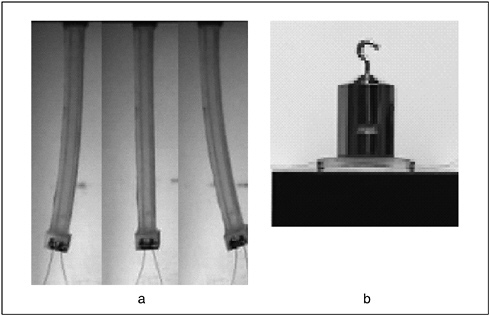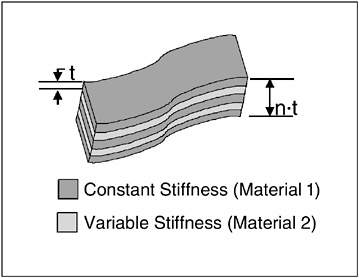The Future of Engineering Materials: Multifunction for Performance-Tailored Structures
LESLIE A. MOMODA
HRL Laboratories, LLC
Malibu, California
In the future, new functional and reduced-scale materials that are currently in the forefront of technology will be hybridized into designer materials that can perform dramatic “tailorable” functions in large engineered systems. These performance-tailored structures will have the ability to change or adapt the performance or style of a structure on demand. Today, engineers can imagine designing adaptive flight profiles from morphing aircraft-wing structures; comforttailored performance, such as active structural vibration and noise suppression or temperature compensation, from louvered or pore-based “smart skins”; energy-efficient structures, such as tropical-plant-inspired solar structures; adaptive structures that can compensate for distortion or heal themselves; and structures reconfigured to satisfy style preferences. Imagine, for example, being able to commute to work in a stately professional car that can be reconfigured into a sportier car for the weekend.
As system-operating scenarios become more constrained by space and logistics limitations, the ability to adapt a structure’s performance at will is becoming increasingly attractive. Currently multi-mission objectives are met with multiple structures (i.e., one car to drive to work and another one for the weekend). These solutions work if there is excess capacity in the system (e.g., a two-car garage), but as the number of mission objectives increases, the procurement, storage, and maintenance of a large number of structures become prohibitive. As a consequence, engineered subsystems that provide structural adaptability are under development in several programs, such as the Defense Advanced Research
Projects Agency (DARPA) Morphing Aircraft Structures Program (Wax et al., 2003), the General Motors Autonomy Concept (Burns et al., 2002), and many structural health-monitoring programs. All of these programs are designed to provide tailored performance in large multicomponent system structures.
Researchers are now thinking about how these same functionalities can be achieved in materials used to construct the system themselves, for example, a thin, smart-material skin that undergoes a radical but controlled change under mechanical strain; a coating that changes color on demand; a shell that reconfigures its shape to meet styling or performance criteria. These materials would enable the same system-level goals that are currently designed as subsystems, but could be more easily integrated into larger engineered structures because they will be lighter, smaller, less difficult to interface, and easier to maintain than current subsystems. Driven by recent advances in biomaterials and nanotechnology, multifunctional materials are emerging as a new interdisciplinary field that promises to provide a new level of functionality, adaptability, and tailorability for future engineered systems.
MULTIFUNCTIONAL MATERIAL SYSTEMS
A multifunctional material is typically a composite or hybrid of several distinct material phases, in which each phase performs a different but necessary function, such as structure, transport, logic, or energy storage. Because each phase of the material performs an essential function, and because there is little or no parasitic weight or volume, multifunctional materials promise more weight-efficient, volume-efficient performance flexibility and potentially less maintenance than traditional multicomponent brass-board systems. The finer and more distributed the integration scale in the material, the faster and more autonomous the reaction times.
Multifunctionality in a material can be integrated on several dimensional scales with increasing interconnectivity between phases and engineering difficulty as the scale decreases. Matic (2003) has categorized these scales as different “types” (Figure 1). Type I material is comprised of phases in which one function is simply mounted, coated, or laminated to another, usually a structural component. Type II materials are comprised of distinct phases in which one function is embedded in another, usually a structural component. Type III materials are truly integrated; the phases are intermeshed, blurring the physical distinctions between them. The true promise of multifunctional materials for performance-tailored structures is most likely to be realized by Type III materials.
Multifunctional materials are designed for improved overall system performance. Thus, their performance metrics are inherently different from their single component phases, in which improvement of a single function, such as electrical conductivity, mechanical strain or force, or energy density, is maximized or minimized. A multifunctional material requires a new design methodology in

FIGURE 1 Schematic representations of the three types of multifunctional materials. Source: Matic, 2003. Reprinted with permission.
which system-level performance is emphasized over the optimization of individual functions. Optimizing system-level performance involves optimization methodologies that are not commonly used in materials science.
FRONTIERS IN MULTIFUNCTIONAL MATERIALS TECHNOLOGY
Materials Technology
The goal of multidisciplinary research on multifunctional materials, much of it under the auspices of the DARPA Synthetic Multifunctional Materials Program (Christodoulou and Venables, 2003), is to demonstrate weight and volumetric efficiencies and performance enhancements. Most research is focused on integrating two functions, usually a transport and structural function, and typically with low interconnectivity (e.g., Type I or Type II). Many of these studies rely heavily on inherently two-phase structural materials, such as fiber composites, laminates, foams, and other porous structures, as the matrix for multifunction. Even at this early stage, however, system-level benefits have been noted.
Structural batteries that reduce weight and complexity by integrating energy storage directly into the load-bearing structure have been developed by several teams using fibers, laminate, and nanotube construction. The energy density of the storage medium, such as a battery or supercapacitor, is reduced as the result of the incorporation of less conductive structural materials. However, the decrease in parasitic structure results in an overall weight savings and, therefore, improved energy density for the system as a whole.
The integration of actuation or sensing mechanisms into tailorable structural materials, which is essential for mechanical reconfigurability and structural morphing, is another area under investigation. Research using metallic foams or highly engineered mesostructured materials (dos Santos e Lucato et al., 2004)
and elastomeric polymers (Pei et al., 2002) has shown tremendous promise for producing large structural motions along with the capacity to integrate actuation for feedback and control. Research conducted at HRL Laboratories, LLC, using hybrid, shape-memory materials (Figure 2), has demonstrated the feasibility of using integrated actuating tendons in a variably stiff matrix to produce low-energy flexure during reconfiguration but shape fixity for structural hold without energy when the motion is complete (W. Barvosa-Carter, personal communication). This concept has been extended to a hybrid laminate (Figure 3), which can produce a two-orders-of-magnitude change in stiffness, essentially from the stiffness of rubber to the hardness of steel, to accompany a shaping actuation force (G.P. McKnight, personal communication).
Self-healing composite structures are also under development (Chen et al., 2002). In these studies, a second phase, such as an adhesive or toughening agent, is added into the structure to ensure resealing on impact. Materials that can integrate other functions into structures, such as electromagnetism, thermal management, and optics capability, are also being investigated.

FIGURE 2 Hybrid shape-memory materials approach to reconfigurable structures. a. Shape-memory tendons actuate a variably stiff shape-memory polymer beam that can be flexed with low-input energy. b. Upon cooling, the beam becomes stiff, locking shape deformations in place to handle exterior loads (here 500 g).

FIGURE 3 Variable stiffness laminate materials concept for producing large structural reconfigurations.
Optimization and Computational Design
Advances have been made in the development of optimization tools for designing integrated multifunctional materials. Sigmund and Torquato (1999) have done extensive work on topological optimization methods to determine the best morphological materials architectures to optimize performance from a highly integrated Type III material embedding of very dissimilar physical mechanisms. Many functional combinations, with as many as three phases, have been simulated. Although their work is purely theoretical, the results of their simulations have been validated by the similarity of the optimized topological solutions to microstructures and mesostructures found in biological systems. Macroscopic optimization tools for the design of less integrated Type I and II multifunctional materials have also been developed (Qidwai et al., 2002).
CHALLENGES AND PROSPECTS FOR THE FUTURE
Two-phase multifunctional systems show the promise of true materials integration. However, truly smart materials systems, analogous to biological systems, will require a combination of three or more functions, including logic, sensing, energy storage, structure, and actuation. Biological systems have perfected multifunction on a small scale. With the design of a priori multiple functions into a materials system, these concepts will be extended into large-scale structures. The complexities of these higher order systems will require a
sophisticated understanding of how basic physical mechanisms can be manipulated to create new, potentially less singly optimal means of achieving function and multivariable optimization tools. For example, to increase the mechanical strength of energy storage systems, either the ionic conduction mechanism could be investigated for new logic capabilities or electrical conductivity mechanisms could be investigated to determine how they might influence mechanical strength.
As our understanding of materials on the nanoscale improves, we will be able to improve our control and increase the range of physical properties of materials even as we decrease the integration scale. Right now, while we are on the verge of understanding and harnessing physics on the nanoscale, we have a tremendous amount of work to do to learn how to fabricate large-scale materials from nanoscale elements. Although self-assembly and biological processing techniques look promising, they are not yet mature enough for the fabrication of multicomponent systems.
New system-level design methodology for materials will change not only the tools a materials scientist must know and understand, but also the role of the materials scientist in the system-design process. Typically, system designers choose from a toolbox of materials that have already been developed, and the materials scientist predesigns these materials to improve a single function. Often the materials scientist, who acts independently of the design team, is present only to characterize data or troubleshoot a problem after design. In the new paradigm, however, the materials scientist must be actively involved from the inception of the system design, providing a finely engineered material on the meso-, micro-, or nanoscale to meet the overall system goals. This will require that the materials scientist be completely familiar with system design tools and computational tools, from the system scale to the micro- or nanoscale. In the future, the design of a new car, airplane, or satellite will truly begin on the atomic scale.
REFERENCES
Burns, L.D., J.B. McCormick, and C.E. Borroni-Bird. 2002. Vehicles of change. Scientific American 287(4): 64–73.
Chen, X., M.A. Dam, K. Ono, A. Mal, H. Shen, S.R. Nutt, K. Sheran, and F. Wudl. 2002. A thermally re-mendable cross-linked polymeric material. Science 295(5560): 1698–1702.
Christodoulou, L., and J.D. Venables. 2003. Multifunctional material systems: the first generation. JOM: The Member Journal of The Minerals, Metals & Materials Society 55(11): 39–45.
dos Santos e Lucato, S.L., J. Wang, P. Maxwell, R.M. McMeeking, and A.G. Evans. 2004. Design and demonstration of a high authority shape morphing structure. International Journal of Solids and Structures 41(13): 3521–3543.
Matic, P. 2003. Overview of Multifunctional Materials. Pp. 61–69 in Smart Structures and Materials 2003, edited by D.C. Lagoudas. Active Materials: Behaviors and Mechanics. Proceedings of SPIE vol. 5053. Bellingham, Wash.: SPIE.
Pei, Q., R. Pelerine, S. Stanford, R. Kornbluh, M. Rosenthal, K. Meijer, and R. Full. 2002. Multifunctional Elastomer Rolls. Materials Research Society Symposium Proceedings 698: 165–170.
Qidwai, M.A., J.P. Thomas, and P. Matic. 2002. Design and Performance of Composite Multifunctional Structure-Battery Materials. Pp. 1–8 in Proceedings of the American Society for Composites Seventeenth Technical Conference, edited by C.T. Sun and H. Kim. Boca Raton, Fla: CRC Press.
Sigmund, O., and S. Torquato. 1999. Design of smart composite materials using topology optimization. Smart Materials and Structures 8(9): 365–379.
Wax, S.G., G.M. Fisher, and R.R. Sands. 2003. The past, present and future of DARPA’s investment strategy in smart materials. JOM: The Member Journal of The Minerals, Metals & Materials Society 55(11): 17–23.








